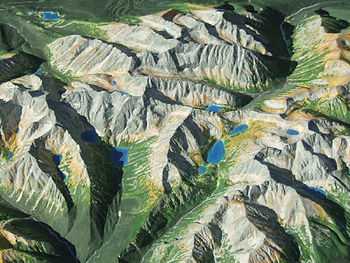Raised-relief map

A raised-relief map or terrain model is a three-dimensional representation, usually of terrain. When representing terrain, the elevation dimension is usually exaggerated by a factor between five and ten; this facilitates the visual recognition of terrain features.
History
If the account of Sima Qian (c. 145–86 BC) in his Records of the Grand Historian is proven correct upon the unearthing of Qin Shi Huang's (r. 221–210 BC) tomb, the raised-relief map has existed since the Qin Dynasty (221–206 BC) of China.[1] Robert Temple and Joseph Needham suggest that certain pottery vessels of the Han Dynasty (202 BC – 220 AD) showing artificial mountains as lid decorations may have influenced the raised-relief map.[2] The Han Dynasty general Ma Yuan (14 BC – 49 AD) made a raised-relief map of valleys and mountains in a rice-constructed model of 32 AD.[1][3] Such rice models were expounded on by the Tang Dynasty (618–907) author Jiang Fang in his Essay on the Art of Constructing Mountains with Rice (c. 845 AD).[1] A raised-relief map made of wood representing all the provinces of the empire and put together like a giant 0.93 m2 (10 ft2) jigsaw puzzle was invented by Xie Zhuang (421–466 AD) during the Liu Song Dynasty (420–479).[1] Shen Kuo (1031-1095) created a raised-relief map using sawdust, wood, beeswax, and wheat paste.[4][5][6] His wooden model pleased Emperor Shenzong of Song (r. 1067–1085), who later ordered that all the prefects administering the frontier regions should prepare similar wooden maps which could be sent to the capital and stored in an archive.[7] In 1130, Huang Shang made a wooden raised-relief map which later caught the attention of the Neo-Confucian philosopher Zhu Xi (1130–1200), who tried to acquire it but instead made his own map out of sticky clay and wood.[7][6] The map, made of eight pieces of wood connected by hinges, could be folded up and carried around by one person.[7]
Later, Ibn Battuta (1304–1377) described a raised-relief map while visiting Gibraltar[8][9] In his 1665 paper for the Philosophical Transactions of the Royal Society, John Evelyn (1620–1706) believed that wax models imitating nature and bas relief maps were something entirely new from France.[10] Some later scholars attributed the first raised-relief map to one Paul Dox, who represented the area of Kufstein in his raised-relief map of 1510.[10][9]
Construction
Starting with a topographic map one can cut out from some sheet material successive layers, with edges following the contour lines on the map. These may be assembled in a stack to obtain a rough approximation of the terrain. This method is commonly used as the base for architectural models, and is usually done without vertical exaggeration. For models of landforms, the stack will then be smoothed by filling with some material. This may then be used directly, or for greater durability a mold may be made from this. This mold may then be used to produce a plaster model.
A combination of computer numerical control (CNC) machining a master model, and vacuum forming copies from this, can be been used to rapidly mass-produce raised-relief maps.
Another method which is becoming more widespread is the use of 3D printing. With the rapid development of this technology its use is becoming increasingly economical.
Non-terrain applications
For appropriate mathematical functions and especially for certain types of statistics, a similar model may be constructed as an aid to understanding a function or as an aid to studying the statistical data.
Notable examples
The Great Polish Map of Scotland is claimed to be the largest terrain relief model, constructed out of brick and concrete in the grounds of a hotel near Peebles, Scotland. It measures 50m x 40m.[11]
However, a site in Ningxia province, China was spotted in 2006 using satellite imagery. It measured 900m x 700m, had a three kilometre perimeter and appeared to be a large scale relief model of Aksai Chin, a disputed territory between China and India.[12]
See also
- Digital terrain model
- Hypsometric tints
- List of Chinese inventions#R
- Musée des Plans-Reliefs
- Participatory 3D Modelling (P3DM)
References
- ↑ 1.0 1.1 1.2 1.3 Temple (1986), 179.
- ↑ Needham (1986), Volume 3, 580–581.
- ↑ Crespigny (2007), 659.
- ↑ Sivin (1995), III, 22.
- ↑ Needham (1986), Volume 3, 579–580.
- ↑ 6.0 6.1 Temple (1986), 180.
- ↑ 7.0 7.1 7.2 Needham (1986), Volume 3, 580.
- ↑ Needham (1986), Volume 3, 579
- ↑ 9.0 9.1 Temple (1986), 181.
- ↑ 10.0 10.1 Needham (1986), Volume 3, 579.
- ↑ Bruce Gittings; Royal Scottish Geographical Society. "Polish Map of Scotland". Gazetteer for Scotland. The Editors of The Gazetteer for Scotland. Retrieved 2012-07-11.
- ↑ "Chinese X-file not so mysterious after all". The Age (Melbourne). July 23, 2006. Retrieved 2012-07-26.
- Ebrey, Patricia Buckley, Anne Walthall, James B. Palais (2006). East Asia: A Cultural, Social, and Political History. Boston: Houghton Mifflin Company. ISBN 0-618-13384-4.
- Needham, Joseph. (1986). Science and Civilization in China: Volume 3, Mathematics and the Sciences of the Heavens and the Earth. Taipei: Caves Books, Ltd.
- Sivin, Nathan (1995). Science in Ancient China: Researches and Reflections. Brookfield, Vermont: VARIORUM, Ashgate Publishing.
- Temple, Robert. (1986). The Genius of China: 3,000 Years of Science, Discovery, and Invention. With a forward by Joseph Needham. New York: Simon and Schuster, Inc. ISBN 0-671-62028-2.
External links
- Terrain Models, a website of the Institute of Cartography at ETH Zurich
- Library of Congress: Geography and Maps - Globes and Terrain Models
- Report of the Relief Map Department, G-2-C, G.H.Q., of the American Expeditionary Forces
- Allan McCollum: The Topographical Model Donation Project
- How to build a landscape-model by Konrad Weber
- Participatory Avenues a web site dedicated to the participatory manufacture of raised relief models in the context of participatory planning, development and advocacy
- Adding the Third Dimension, an article (PDF 744KB) that describes ways of creating maps that "effectively present the third dimension."
| Wikimedia Commons has media related to Cartographic relief. |